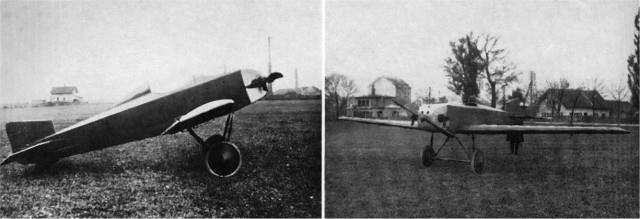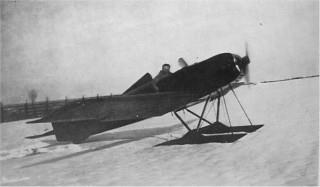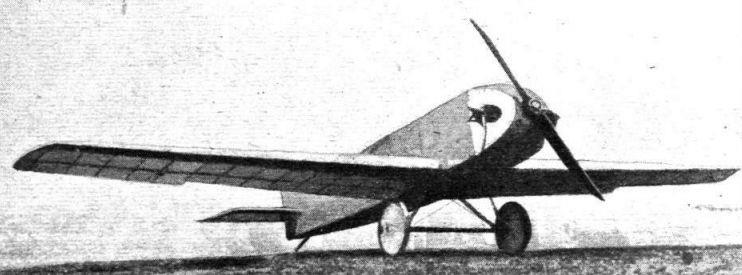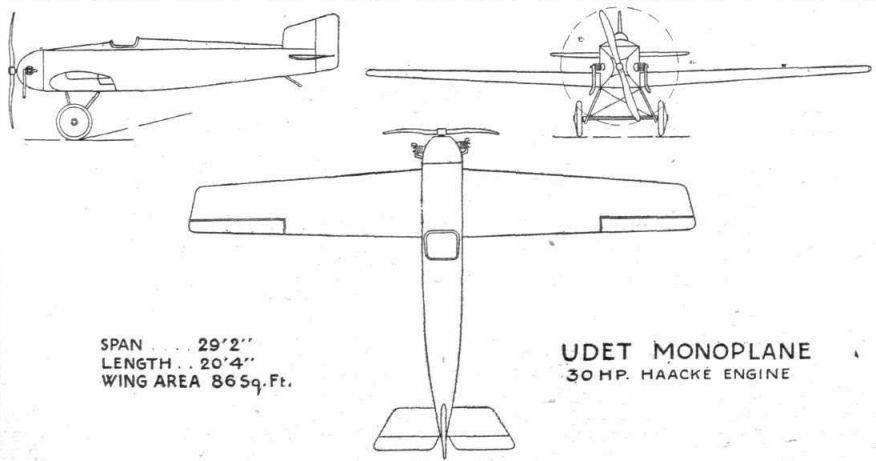THE UDET SPORTING SINGLE-SEATER
The Production of a Newcomer to the German Aircraft Industry When it was announced that, subject to certain limitations in engine power, Germany would become free to construct aircraft again, we expressed the opinion that probably the regulations would result in a considerable increase in the aerodynamical efficiency of German machines, and that quite a crop of new small machines would be produced. We have recently described several such, and this week we are in a position to give particulars of yet another small single-seater, this time produced by a firm which has but recently been formed. The firm, which has its headquarters in Munich, is known as the Udet Aircraft Works, and was founded by Capt. D. Udet, who was a well-known German air-fighter during the War. Incidentally, the new Udet sporting monoplane is, as far as we are aware, the first post-War machine to be designed and built in Bavaria. The Udet monoplane- was designed by Capt. Udet's technical assistants, Hans Herrmann and A- R. Weyl, and is, as will be seen from the accompanying illustrations, of the cantilever type, with the wing placed low as in the Junkers machines. The machine is characterised by having wings of the, for a cantilever type, unusually high aspect ratio of about 9 to 1. Usually, a much lower ratio is employed for wings of this type in order to keep down the stresses. There Is little doubt, however, that the higher aspect ratio results in a considerable improvement in efficiency, as well as in making the machine a good deal nicer to handle, and from the fact that the weight empty of the whole machine is only 440 lbs., the wings cannot be excessively heavy.
In the construction of the Udet monoplane wood has been largely employed, especially in the form of three-ply, with the exception of the engine mounting, controls and undercarriage. The wing is built up in one piece, of three-ply ribs, on two box spars having spruce flanges and three-ply sides. One of our photographs gives an idea of the general construction. The area of the wing is only 86 sq. ft., and as the weight of the machine, fully loaded, is 640 lbs., the wing loading is 7.44 lbs. per sq. ft. We have no information relating to the wing section used, nor to the landing speed of the machine, but it is stated that, owing to the good shape of the wing, the machine would easily carry a passenger, with the same small engine. With regard to the structural strength of the wing, we are informed that the factor of safety is everywhere larger than 7 ; in the case of the front spar it is even stated to be over 10. The designers have worked to such high factors of safety that, even in the hands of comparatively inexperienced private owners, it would be difficulty not to say impossible, so to manoeuvre the machine as to cause breakage in the air. Ailerons of large aspect ratio, although of small area, are hinged to the rear spar.
When in place on the machine, the wing spars rest in a recess in the bottom of the fuselage, the lower longerons of which are suitably strengthened to receive them, and are held in place by eight large bolts. It appears that to remove the wing from the machine it is necessary to remove the undercarriage, but as there is no bracing between the rear legs, and the struts are anchored by easily detachable ball-and-socket joints, the operation should not occupy many minutes. When removed, the wing is placed on special trestles above the fuselage, and the machine can, it is stated, be towed by placing the tail skid on the carrier of an ordinary motor-cycle. In fact, the machine was recently thus transported through the streets of Munich, much to the amusement of the passers by.
The fuselage, which is of rectangular section with a slightly curved deck, is covered with three-ply, so that no wire bracing is employed. An exception is the front portion, which carries the 30 h.p. Haacke engine. This part of the fuselage is built up of steel tubes, and is so arranged that the whole engine can be moved a few inches in a fore-and-aft direction for purposes of trimming. As the weight of the engine is only about 140 lbs., however, it is hardly to be expected that a movement of a couple of inches can have any noticeable effect on the trim of the machine. The pilot's seat, it will be seen, is placed relatively far aft, in view of the light engine, and as a matter of fact we understand that in the next machine it will be moved farther forward. For the two-seater in contemplation, the present location will be retained. The controls are of the usual type, and do not call for any comment.
The petrol tank is carried in the upper portion of the fuselage, behind the fireproof bulkhead, and it is claimed that sufficient head can be maintained for direct gravity petrol feed. Normally, sufficient fuel is carried for 2,5 hours' flight at full throttle, but if it is desired to make longer flights extra tanks can easily be fitted. The undercarriage is of usual Y-type, with struts of stream-line steel tube, attached to the fuselage by ball-and-socket joints and having cross bracing in the front bay only. The wheel track is only 4 ft. 10 ins. A peculiarity of the design is the position of the undercarriage. From the side elevation it will be seen that the wheels are unusually far back, and one would imagine that the machine might have a tendency to stand on its nose. Probably, when the pilot's seat is shifted forward, the undercarriage will be moved forward also.
Beyond stating that they are of the cantilever type, the tail surfaces call for no comment, except to point out that the tail plane appears to be negatively cambered, as in some of the Pfalz machines of the War period.
During recent test flights, the Udet monoplane, piloted by Capt. Udet, is stated to have behaved very well, although certain modifications are still necessary before putting it into production. When these have been effected the machine should appeal to many on account of its low running cost.
It might be mentioned here that for manv months now there has been in existence in this country a small monoplane on very similar lines to those of the Udet. This is a Bristol machine, with the fuselage of the Bristol "Babe," fitted with cantilever wings placed low on the body.Jfc This machine has one of the 60 le Rhone engines, but has not yet. we believe, been flown.
The main features of the Udet monoplane may be gathered from the following brief specification :-
Engine. 30-40 h.p. Haacke (2-cylinder opposed air-cooled); length, o.a., 20 ft. 4 ins.; span. 20 ft. 2 ins.; maximum chord, 4 ft. ; minimum chord, 2 ft. 7 ins. ; wing area, 86 sq. ft. ; height, 5 ft. 7 ins.; weight of machine empty, 440 lbs.; weight fully loaded, 640 lbs. ; power loading. 16 Ibs./h.p. ; wing loading. 7,44 lbs./sq. ft.; maximum speed, 180 km . (110 miles) per hour; climb to 3.300 ft. in six minutes; duration with standard tanks, 2,5 hours.
| Type |
Single seat sportplane |
| Engine |
1 Haacke 30 hp |
| Dimensions |
Length 5.33 m, height 1.70 m, span 8.90 m, wing area 8.00 m2, aspect ratio 9.95, max. chord 1,22 m, min. chord 1,93 m |
| Weights |
Empty 200 kg fuel 20 kg, pilot 70 kg, flying weight 290 kg |
| Performance |
Max. speed 180 km/h, climb to 1000 m 6 min., endurance 2.5 h |
| Type |
Werk.Nr |
Registration |
History |
|
|
|
|





